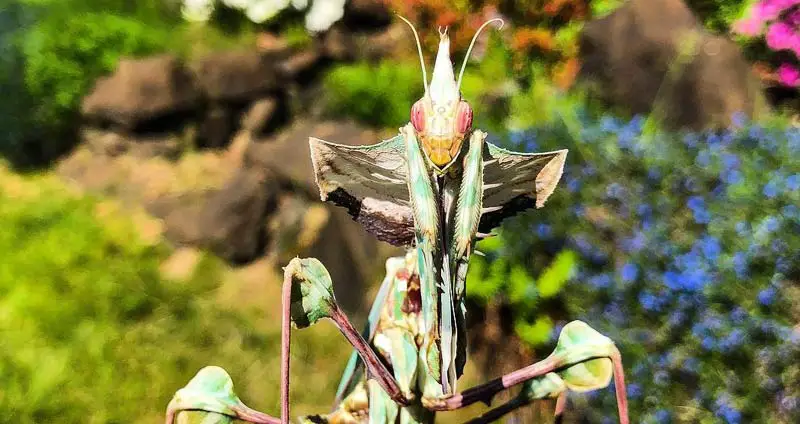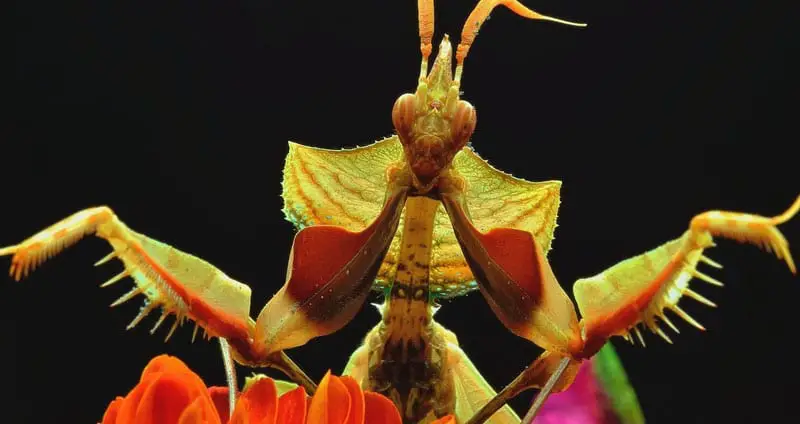Praying mantis are some of the most unique-looking and interesting creatures that you can possibly own. While all species are certainly bizarre, Idolomantis diabolica takes the cake for one of the largest, strangest, and most beautiful praying mantis species in existence.
It’s safe to say that this is a top-of-the-line mantis, acting as a sort of end goal for mantis keepers. Despite the fact that this mantis is quite expensive and difficult to care for, it’s certainly accessible once you have experience caring for more basic species.
Whether you simply want to know more about this creature or if you plan on keeping one in the future, reading this care sheet will tell you everything that you need to know about the Devil’s Flower Mantis.
Table of Contents
Idolomantis diabolica Appearance
If you’re looking for a unique insect pet, you don’t need to look any further. Idolomantis diabolica has an appearance and colors that mimic flowers, helping them to hunt and even to avoid predators. They don’t always look this stunning, though.
Right after they’re born, nymphs are a shiny black color. As they age, they take on a more beige to light brown color — not a very impressive coloration. However, as adults, they’re much more impressive. Adult mantids feature white and green stripes on the readily visible parts of their bodies. On the inside of their arms, they have colors ranging from blue to red to black, only displaying these colors when threatened.
While they have unique appendages early in life, they only get more unique and pronounced as they age. Leaf-like appendages start to form with several on the legs, head, and abdomen and a large shield-like one on the back.
In terms of size, this mantis is quite impressive as well. Adult females will reach about 4-5 inches in length, with males also reaching that size but having longer antennae and a more slender body.

via @colubrids101 / Instagram
Idolomantis diabolica Temperament
Despite the fact that this is one of the largest and most impressive mantis species in existence, its temperament doesn’t quite match its appearance. Idolomantis diabolica is very easily stressed and will act skittish most of the time. While some specimens will eventually trust their owners, others will simply never quite warm up to them.
When stressed enough, this mantis can react to the stress. This includes running around manically, bumping into nearly everything around them, and potentially showing off their deimatic display. Constant stress is stated to reduce the lifespan of this creature, so it’s best to avoid stress at all costs.
One thing that Idolomantis diabolica is known for is that stunning deimatic display that was just mentioned. Its particular display involves it raising its front legs and sticking them out, shwoing off the brightly-colored area inside of their legs. In addition to this, it will move its body and arms side to side while opening its wings to appear larger. Some people try to make their mantids display, but induced stress should be avoided.
Unfortunately, avoiding stress likely means avoiding handling this mantis altogether. As it’s quite large, easily spooked, and can even fly, handling isn’t the best activity. Instead, keeping them more as a display insect is recommended by experts. It’s not bad to handle them every once in a while to remove them from their enclosure, though.
This is more of a sit and wait species. They use their floral body to camouflage and simply wait for prey insects to walk right past them. It then uses its mandibles to grab the prey, decapitate them, and quickly devour them.
Housing Idolomantis diabolica
It’s extremely important that this mantis is given an appropriate enclosure. Typically you’ll want to provide an enclosure that’s at least 3 times the height of your mantis and at least twice as wide. A large enough cage is essential to help make molting more comfortable and keep the mantis stress-free.
The Devil’s Flower Mantis is native to several different countries within East Africa — an area that’s typically tropical but contains a range of different environments. It’s important to match your Idolomantis diabolica enclosure to their native habitat since they’ve evolved to thrive in that climate for many years.
In terms of climate, this mantis can handle a wide array of temperatures. Some experts say that they should be kept around 90F, while others note that they can thrive right around high 70s, or room temperature. A stable temperature can be achieved with either a heat lamp shining on the enclosure (highly recommended) or a space heater placed in the room that the enclosure is in.
Humidity doesn’t need to be too high for this species. Many owners keep their mantids in enclosures that are fairly dry, only misting them once a week or every other week. Make sure that there is good ventilation though — something that you won’t need to worry about if you invest in a mesh cage.
Optimal Enclosure
While Idolomantis diabolica has species requirements for its enclosure, it isn’t difficult to meet those requirements. As stated, the enclosure itself should be very sizable, and you can never really go too big with mantis enclosures. The Exo Terra 12″x12″x12″ enclosure is perfectly suitable for an adult specimen, providing plenty of height, floor space, accessibility, and breathability.
If you want to house several mantids communally, you may want to invest in a larger enclosure to prevent them from feeling cramped. If you want to go substantially larger, there’s an 18″x18″x24″ enclosure available.
It’s important to note that this mantis can’t walk on smooth surfaces and certainly can’t climb up glass. Therefore, it’s typically a good idea to purchase a wire mesh enclosure that will allow them to climb and latch onto the sides and ceiling.
The enclosure should be decorated with an array of different accessories, but you don’t need to overdo it. This includes dry leaves, sticks, cork bark and any other material that the mantis can hide behind or climb on. Glass enclosures will need many more accessories than mesh enclosures to help the mantis climb and gain its footing.
Idolomantis diabolica diet
As they are from the Empusidae family and mimic the appearance of flowers, this mantis almost exclusively feeds on flying insects. They don’t hunt for prey, they simply sit and wait for something to fly right past them, allowing them to quickly grab and subdue the passing insect. Therefore, feeding this mantis is quite simple.
Young nymphs should exclusively be fed fruit flies due to their smaller size. However, as Idolomantis diabolica ages, it can be fed green bottle flies, blue bottle flies, and even moths. Some owners even get a bit creative with feeding and have great success with craneflies, butterflies, stinkbugs, and bees.
This is a species that should always have a steady supply of flies and should be fed every day. Make sure not to crowd the enclosure with too many flies at once, as this can cause overcrowding and thus result in stress-related health problems. If you’re opting for a communal setup, several flies in the enclosure would be acceptable.
A few Idolomantis diabolica owners feed their mantids dubia roaches. This is done by gut loading the roaches with nutritious foods like honey, fruit, and vegetables to make sure that they’re healthy for the mantis. Then, they’re moved with tongs into the range of the mantis for an easy take-down.
Health Issues
This is one of the most difficult mantids to keep, with many specimens’ lives getting cut short by unknown health problems. There are things that you can do to give your Idolomantis diabolica the best chance of reaching the end of its expected 12 month lifespan.
First and foremost, make sure that the enclosure is very well-ventilated with proper temperatures and humidity levels. This is important for several reasons, but most notably contributes to the success of their molts.
Molting is the #1 killer for this mantis species due to their extremely intricate body shape, so a lot needs to go into making sure that they’re successful. Proper temperature, humidity, and ventilation will help make the molt much easier and greatly increase the chances of success.
Stress is also a huge killer for this mantis. There are many ways that stress can reduce the lifespan of the Devil’s Flower Mantis, so do all that you can to reduce stress in their lives. Make sure that enclosures are big and easy to climb, prevent overcrowding with food and other mantids, and keep handling of this species to an absolute minimum.
Purchasing Idolomantis diabolica
Since this is such a unique mantis that’s highly desired by a lot of people, it can also fetch quite a high price for a mantis. Therefore, to make sure that you’re not wasting your money (and to ensure that you’re giving a mantis the best life possible), gain experience by taking care of easier mantids first.
There are several online marketplaces that have this mantis for sale. You can buy them as a young nymph (which is recommended), a juvenile, or an adult. You can purchase an L1 or L2 nymph for around $30, with the price slightly increasing as the specimens get older.
While this price is decently high for a single mantis, it’s still quite an impressive deal. $30 for a year of ownership of one of the most impressive mantis species in existence is something most enthusiasts won’t think twice about. Of course, the cost of supplies will tend to outweigh the cost of the mantis itself, but total ownership costs are still quite low.

